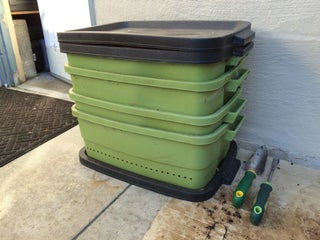 Reduce your food waste, learn about biology, and support a healthier garden by composting
Reduce your food waste, learn about biology, and support a healthier garden by composting
A compost bin or pile is used to collect material we would otherwise throw in the trash can - household food scraps and leftovers, coffee grounds and tea bags, eggshells, and more. These materials decay or decompose and turn into compost, a mud-like material that can be added to a garden or yard to produce healthier soil.
The average American family creates about eighteen pounds of trash per day - that's equal to the weight of three bricks! Most of that waste is sent to a local landfill, where items like plastic wrappers can take hundreds of years to degrade. Items in your recycling bin may also end up in a landfill. Landfill waste is harmful to the environment because it produces a powerful greenhouse gas called methane, which contributes to climate change. Climate change will dramatically change the way humans live on this planet and have major effects on our communities, health, food, and more. Learn more about climate change here.
Learn more about the environmental impact of food waste in the US.
Composting can dramatically reduce the amount of landfill waste or trash that your family creates. Here are some steps and resources to guide you on your compost journey:
Pick a location
Find a place in your yard that gets some sunshine and won't disturb you or your family. If you don't have a backyard and want to compost, consider a worm box or find a place to drop off compost in your neighborhood (the Cobblestone Farmer's Market and some community gardens will let you drop off your compost).
Start a pile or make/buy a bin
Many people compost in a pile without a structure or bin. A bin can be useful if you are worried about keeping your compost neat and not attracting wildlife. You can purchase a ready-made compost bin from a hardware store or use something around the house like an old dresser or storage tub to make your own box. Many websites provide instructions for building a compost structure.
If you don't have access to a yard or outdoor space, consider making a worm bin, which can be stored inside or in a garage. Learn more about worm bins here:
Store your food scraps
Choose a bowl or bag to keep your food waste and get in the habit of filling it up with your fruit and vegetable peels, coffee grounds, and more. We recommend keeping your compost bowl in the fridge or freezer to avoid the dreaded fruit fly and to encourage faster decomposition.
Start composting!
Time to get a little dirty and start adding to your pile. Click here to visit a PEA blog detailing what goes into your bin and other composting tips.
Other great resources on composting:
Don't forget to send us a photo of your compost bin/pile or you working on it. Make sure to tag @peancorg and #PEAYoungLeaders to be entered into the weekly Young Eco Leaders Raffle.
CLICK HERE TO RETURN TO THE LIST OF ALL YOUNG ECO LEADERS ACTIVITIES